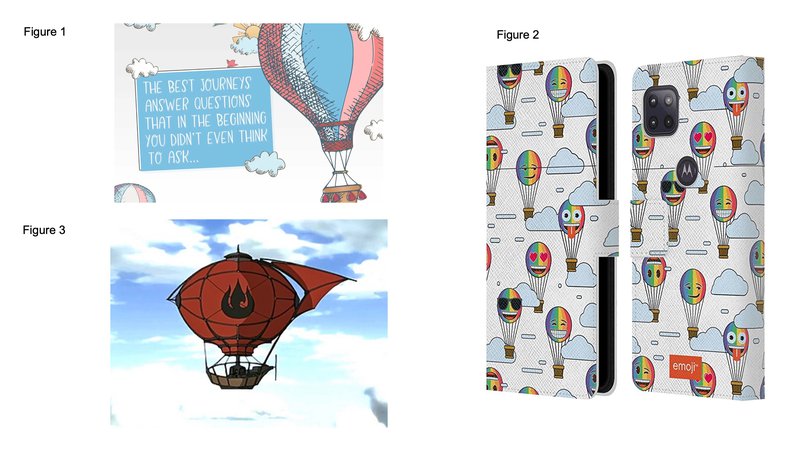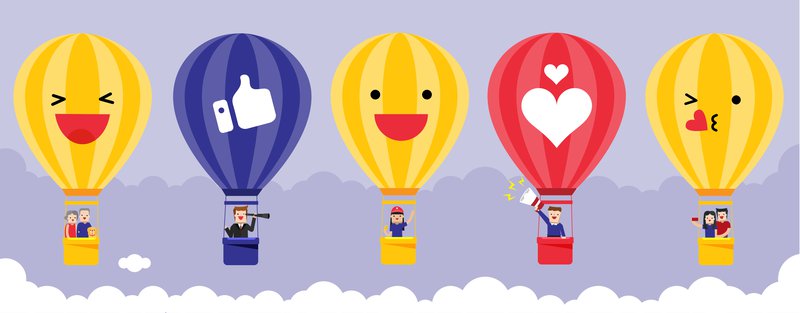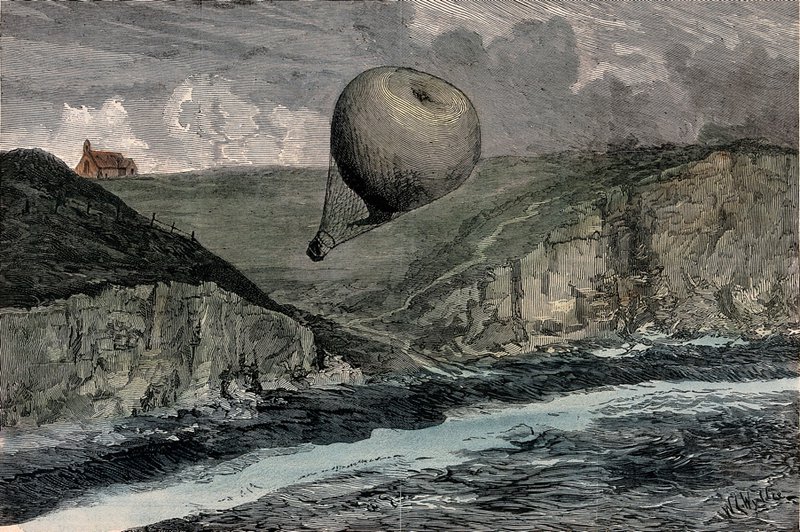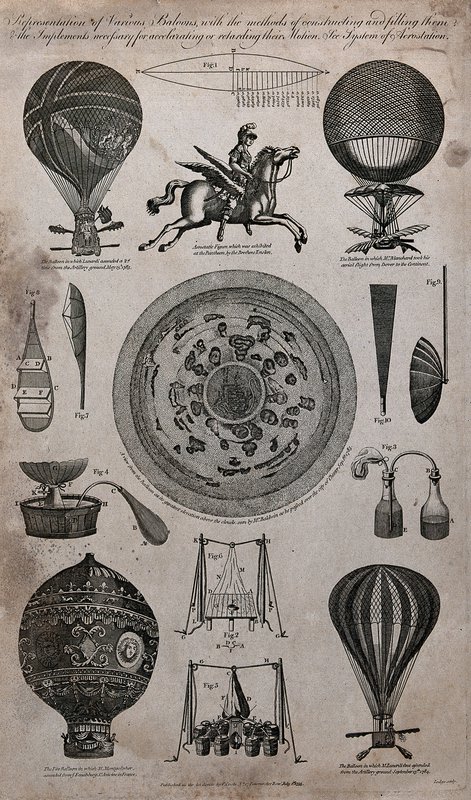Balloons as Imaginative Agents
A question appears on Quora.com, a discussion site, asking “Why isn’t there a hot air balloon emoji?” At the time of writing (2019), no answer has been posted. In this piece, I want to explore the question, or why there is more to it than first meets the eye. Emojipedia reports there is a balloon emoji:
🎈 Balloon
A balloon on a string, as decorates a birthday party. Generally depicted in red, though WhatsApp’s is pink and Google’s orangish-red. Commonly used to convey congratulations and celebration, especially when wishing someone a happy birthday. Microsoft and Samsung's balloons were previously blue; SoftBank's was shown floating in the sky.
Balloon was approved as part of Unicode 6.0 in 2010 and added to Emoji 1.0 in 2015.1
But that is not a hot air balloon. Redbubble.com offers one, curiously anthropomorphized with sunglasses and a smile.2
A more functional hot air balloon, with visible fire (but nobody to tend it) appeared on a blog post (updated and simplified version at https://blog.joypixels.com/how-to-submit-an-emoji-to-unicode/) that took you through the steps necessary to propose a new emoji to Unicode, one of the big gatekeepers. The tenth step was
Transient – Are people going to want to use this emoji over time? I think it’s safe to say that hot air balloons aren’t a fad…
Indeed. They were invented in 1783, an invention usually attributed to the Montgolfier brothers, though Joseph, who was interested in hydraulics, was probably more of the designer than Etienne, who had more of a talent for development and display. The Montgolfiers weren’t initially sure what made hot air rise, and in any case, at almost the same time, there was an equally successful alternative, a balloon whose globe was filled with a gas that we know as hydrogen (“inflammable air” was the usual term used by eighteenth-century chemists). Under the auspices of a professor from the Paris Académie des Sciences, M. Charles, and two engineer brothers, the Roberts, hydrogen balloons broke records for distance, altitude, and flight time. The hot air balloon continued as a platform for adventure and experiment but with liabilities, mostly associated with the difficulties of controlling a fire aloft. It was the hydrogen balloon which was made of gores or segments (usually of silk) that were sewn together, giving the stripey appearance which perversely appears on the hot air emoji icon. Additionally the hydrogen balloon had a valve that enabled gas to be put in or let out, and netting to keep the gas-inflated envelope an even shape. Of course using the stripey signifier for the type of balloon that needs less human intervention may account for its reappearance in a digital icon where the point is the balloon, not the aeronauts, but that seems a recherché explanation. And an unlikely one.
So what is going on? Why might people want a hot air balloon icon? There are emoji icons for a rocket (approved for Unicode 6.0 in 2010 and added to Emoji 1.0 in 2017), a flying saucer (Unicode 10.0 and Emoji 5.0, both 2017) and a Vulcan Salute ( Unicode 7.0, 2014 and Emoji 1.0, 2015). There are also emojis for an airplane, helicopter, sailboat, and speedboat. In 2019, new emojis included a variety of accessibility – related designs – people in wheelchairs, with canes, with prosthetic limbs. You can send a flamingo, a waffle, and a Hindu temple – but no hot air balloon, unless you use cumbersome composite icons from Apple.3
There is an Air Balloon typeface for sale online – hand drawn, and with a balloon complete with ropes drawn through hoops and sandbags (correct!). Examples with text gesture to metaphysical adventure (Figure 1 ).4
An “Official Emoji Hot Air Balloon Pride” phone case is available to buy on Amazon, with smiley-related expressive faces. Matching rainbow hues to balloon gores is neatly done (Figure 2).

Conversely, some actual balloons mimic emoji design. That’s quite a natural fit, given the similarity between the shape of a human head and a more or less round balloon.5 See Oswestry Balloon Carnival’s November 2018 Instagram post6 expressing excitement at @emoji.balloon’s plan to visit during the 2019 Carnival.
On social media, #hotairballoon is notably popular: there are 1,335,295 posts on Instagram (April 30, 2019), many of which are promotional shots of balloon ascents in holiday destinations (Cappadocia in Turkey especially). Comments include reactions of WOW, awesome, beautiful as standard.
Hot air balloon tags don’t garner the more than 5 million posts on Instagram of their junior descendants, the toy balloon, which has its own interesting history as a philosophical plaything. Still, they float into popular culture in numerous ways: for instance in Disney’s film Up (2009)7 which inspired some ingenious imitations off-screen.
The Lighter-than-Air Society reported on a 2013 recreation of the house suspended under a multitude of balloons:8 A viable design, though the pilot, enclosed in the house below the big balloon with 540 balloons painstakingly sewn onto it, had to fly blind.

Fire balloons feature quite extensively in Avatar: The Last Airbender (American TV 2005–2008, see above) as a technology initially associated with the Fire Nation, but adopted and adapted by the kingdoms resisting them.9
It is characteristic of hot air balloons to test powers of control: hence they become an emblem of flight needing skill. That’s true too of hydrogen balloons, but the predominance of balloons fired up by propane in leisure and fiesta contexts means the flame associated with hot air balloons is more familiar, and indeed globally familiar, given the popularity of hot air flight as a leisure activity around the world. Why is there not an emoji? A hot dog emoji, similarly missing in 2015, has now been added to the emoji lexicon. Requests for one (partnered with astronaut) turned up on an Apple discussion forum.10
The comment thread reveals that Mac users worry about hot air in relation to fans meant to cool their devices; that balloons are used as a description of some graphic bubbles related to functions like help; that hot air balloons survive as a metaphor for things hard to control. Ppffffft, as one user describes malfunction: like air escaping from a balloon.
The association between balloons and emotions is imaged in this:11

“Illustration vector flat cartoon of emoji balloon social media icon with clouds, happy people old and young, boy and girl, businessman and student, couple family and single together – Vector”
is how the listing describes it. Happiness and balloons go together iconographically because positive emotions are usually described as upbeat, up moods; low moods point downwards. In Air and Dreams (1943) Gaston Bachelard discusses what he calls ascensional psychology – the forces that run through our thinking about up (and down). He is an astute theorist and critic. In a chapter titled “Imagination and Mobility” he thinks about the relations between imagination and movement (compare “a leap of faith”) which can be clearly seen in air.
“It seems as though the flying creature goes beyond the very atmosphere in which he flies. It seems that there is always an ether to transcend the air, and that an absolute is the final stage of the consciousness of our freedom.”12 For Bachelard, aerial imagery serves imagination by imaging release, gaiety, lightness, and a vertical differentiation which expresses what he calls the life of the soul, its delicate emotions and hopes and fears. We might think of it in terms of aspiring – for instance, being upwardly mobile, or rising to occasions, or ascending like wishes or prayers. Bachelard recognizes the difficulties of explaining such powerful principles:
metaphors of height, elevation, depth, sinking and the fall are the axiomatic metaphors par excellence. Nothing explains them and they explain everything. Put more simply, if a person is willing to live them, feel them, and above all compare them, he realises that they have an essential quality and that they are more natural than all the others. They engage us more than visual metaphors do – more than any striking image can. And yet language is not particularly well-suited to them. Language, conditioned by forms, is not readily capable of making the dynamic images of height picturesque. Nonetheless, these images have amazing power: they govern the dialectic of enthusiasm and anguish. Vertical valorization is so essential, so sure – its superiority is so indisputable – that the mind cannot turn away from it once it has recognized its immediate and direct meaning.13
I quote this at length to invoke the meshing of air, upwardness, and imagination – which are all evoked by a balloon aloft. The difficulty of articulating them in words, or even in visual images, if anything adds to their power. Psychoanalysis might say the dynamic of up (and down) has unconscious pull, which is precisely what prevents us from easily expressing it. This is where balloons come in. When their inventors first attempted ascents, there were strong rational reasons for emotions around balloons. Crowds gathered to witness, hoping for success, fearful of accident. A dialectic of enthusiasm and anguish ran through the ups and downs of getting aloft and swirled around balloons themselves as Enlightenment objects: capable, perhaps, of enabling travel in new ways, maybe as far as the moon or even beyond; as vehicles of exploration that would take humans into new places and zones of perception; as platforms for scientific discoveries; as a means of raising humans to the heavens, with all their inscription of myths and religion. Balloons mobilized imagination, in other words, as people wondered extensively about how movement through air could extend and transform human experience. I discuss this in depth – and airily – in my book Balloon Madness: Flights of Imagination in Britain, 1783–1786 (Boydell, 2017). To take just one example, a young woman from Bristol published a poem in 1786 in which flying in a balloon, imaginatively, enabled feelings of power, pride, and pleasure:
We in these aether castles ride
With all the equipage of pride,
And in imagination rise,
Superior monarchs of the skies.14
Just a few years after balloons arrived on our imaginative scene, they no longer seemed to hold the promise of possibility. For a start they could not be steered against a wind, so flight could not be a controlled process. Too random and anarchic to deliver for science, especially with the turbulence of revolution disrupting the co-operation between countries which made transnational flight desirable, interest in balloons dwindled.

La Presse Illustrée. Dimanche 28 Juillet 1878. Le grand ballon captif de Tuileries. ...
On December 10, 1881, Walter Smith, colliery owner and Conservative MP, was carried out to sea in a balloon; he was never seen again.
Except, balloons resonated powerfully with poets, who kept metaphors of aerial flight going, and continued to develop them as symbols of aspiration, longing – and the ineffable. To take just one example: William Wordsworth, gazing at a full moon outside his house, reached for balloons as a potential image:
There’s something in a flying horse,
There’s something in a huge balloon,
But through the clouds I’ll never float
Until I have a little boat,
Shaped like the crescent-moon.15
The moon was firmly anchored as a symbol of imagination for Romantic poets; linking balloons to Pegasus, the flying horse of ancient poetry, gives Wordsworth a dynamic image for height and hence imagination, in Bachelard’s terms.
Hot air balloons had a revival of sorts in the steam age – and another imaginative recuperation through the more recent Steampunk movement, which uses historical technology, especially steam-driven, for science fiction and fantasy. If balloons could be steam-powered, air travel could at last be directed purposefully. A fantasy from a humorous magazine in 1834 groups steam-powered balloons, wing kits, railroads, and moveable houses together as imaginings from an imagined future. Bachelard’s association of imagination and mobility, and imagination as mobility, is beautifully anticipated. Anticipating too the twentieth century as a time of invention, the artist includes balloons as a means of expressing future imagination.

Below we see an eighteenth-century arrangement of different models of balloons, of which only the one bottom left, the classic Montgolfier design, is actually a hot air balloon. In part it was to inform about the technical differences between hot air and hydrogen balloons. Besides showing various bits of apparatus for filling and attempting to steer, the print includes a figure of Pegasus, associated with poetic imagination, and an aerial view of Chester in the middle, as drawn by Thomas Baldwin and printed in his Airopaidia (1786). The engraving was first published in 1795 – an instance of balloons’ staying power in imagination despite failure to develop in practice.

In a hunt for illustrations to this essay, I was very grateful to the Wellcome Collection for enabling fuss-free and free reproduction. But I was also really surprised to see one of the UK’s top research collections index all its balloon images as hot air balloons. Even a bad balloon scholar should know the difference – and the importance of that difference – between a hot air balloon and a gas-filled balloon! But misleading labels are eloquent: it’s as if the ur-form of balloon is hot air. In the eighteenth-century, much fun was had with the comic possibilities of hot air balloons, as symbols of windiness, pomposity, even fraud. The Wellcome labels have simply taken hot air as synonymous with any kind of balloon, perhaps in an unconscious association of heat and air with imagination, in a happily Bachelardian way. Questionable accuracy becomes assured aesthetics: it’s wrong, but it’s imaginatively on track nonetheless. It is also a mistake repeated so many times online it becomes a kind of imaginative truth. Accuracy about technologies of flight matters less than having a constant image – a balloon – for imaginative possibilities.
The hot air balloon, then, has a long history of symbolizing imaginative possibilities. That history continues to unfold in popular culture, including online culture. It is still meaningful to imagine imagination by an image of a balloon, however technologically inaccurate, because a hot air balloon carries for us a whole weight of imaginative engagement.

Endnotes
- “🎈 Balloon,” in Emojipedia, accessed April 4, 2023, https://emojipedia.org/balloon/. ↩
- HippoEmo, “Hot Air Balloon Emoji,” Redbubble, accessed April 4, 2023, https://www.redbubble.com/people/hippoemo/works/28915115-hot-air-balloon-emoji. ↩
- “Hot Air Balloon,” Emoji Meanings, 2020, http://www.emojimeanings.org/hot-air-balloon/. ↩
- Salt and Pepper Designs, “Air Balloon Font,” Font Bundles, May 31, 2020, https://fontbundles.net/salt-and-pepper-designs/130735-air-balloon-font. ↩
- https://www.imgrumweb.com/post/BqZbULkFPxN. Accessed July 31, 2019 but no longer live. ↩
- Oswestry, “We Are Excited to Have...,” Instagram, November 20, 2018, https://www.instagram.com/p/BqZbULkFPxN/. ↩
- Disney UK, “Pixar’s Up: Official Trailer,” YouTube, 2009, https://youtu.be/ORFWdXl_zJ4. ↩
- LighterThanAirSociety, “A Wonderful Hot Air Balloon Inspired by Disney Pixar’s ‘Up,’” The Lighter-Than-Air Society, February 6, 2013, https://www.blimpinfo.com/uncategorized/a-wonderful-hot-air-balloon-inspired-by-disney-pixars-up/. ↩
- “Hot Air Balloon,” in Fandom: Avatar Wiki, 2008, https://avatar.fandom.com/wiki/Hot_air_balloon. ↩
- Slanay, “Emoji Request,” Apple: Community, November 1, 2018, https://discussions.apple.com/thread/8610472. ↩
- unturtle, Illustration Vector Flat Cartoon of Emoji Balloon..., EPS Vector, 6502 x 2551 pixels, accessed December 4, 2020, https://www.shutterstock.com/image-vector/illustration-vector-flat-cartoon-emoji-balloon-1083799658. ↩
- Gaston Bachelard, Air and Dreams: An Essay on the Imagination of Movement., trans. Edith R. Farrell and C. Frederick Farrell (Dallas, Tx.: Dallas Institute Publications, 2002). 8. ↩
- Idem. 10. ↩
- Clare Brant, Balloon Madness: Flights of Imagination in Britain, 1783–1786 (Suffolk, UK: Boydell and Brewer, 2017). 58. ↩
- William Wordsworth, Peter Bell: A Tale in Verse (London: Longman, Hurst, Rees, Orme, and Brown, 1819). lines 1-5. ↩
Bibliography
- Bachelard, Gaston. Air and Dreams: An Essay on the Imagination of Movement. Translated by Edith R. Farrell and C. Frederick Farrell. Dallas, Tx.: Dallas Institute Publications, 2002.
- Brant, Clare. Balloon Madness: Flights of Imagination in Britain, 1783–1786. Suffolk, UK: Boydell and Brewer, 2017.
- Disney UK. “Pixar’s Up: Official Trailer.” YouTube, 2009. https://youtu.be/ORFWdXl_zJ4.
- HippoEmo. “Hot Air Balloon Emoji.” Redbubble. Accessed April 4, 2023. https://www.redbubble.com/people/hippoemo/works/28915115-hot-air-balloon-emoji.
- LighterThanAirSociety. “A Wonderful Hot Air Balloon Inspired by Disney Pixar’s ‘Up.’” The Lighter-Than-Air Society, February 6, 2013. https://www.blimpinfo.com/uncategorized/a-wonderful-hot-air-balloon-inspired-by-disney-pixars-up/.
- Oswestry. “We Are Excited to Have...” Instagram, November 20, 2018. https://www.instagram.com/p/BqZbULkFPxN/.
- Salt and Pepper Designs. “Air Balloon Font.” Font Bundles, May 31, 2020. https://fontbundles.net/salt-and-pepper-designs/130735-air-balloon-font.
- Slanay. “Emoji Request.” Apple: Community, November 1, 2018. https://discussions.apple.com/thread/8610472.
- unturtle. Illustration Vector Flat Cartoon of Emoji Balloon... EPS Vector, 6502 x 2551 pixels. Accessed December 4, 2020. https://www.shutterstock.com/image-vector/illustration-vector-flat-cartoon-emoji-balloon-1083799658.
- Wordsworth, William. Peter Bell: A Tale in Verse. London: Longman, Hurst, Rees, Orme, and Brown, 1819.
- “🎈 Balloon.” In Emojipedia. Accessed April 4, 2023. https://emojipedia.org/balloon/.
- Emoji Meanings. “Hot Air Balloon,” 2020. http://www.emojimeanings.org/hot-air-balloon/.
- “Hot Air Balloon.” In Fandom: Avatar Wiki, 2008. https://avatar.fandom.com/wiki/Hot_air_balloon.
